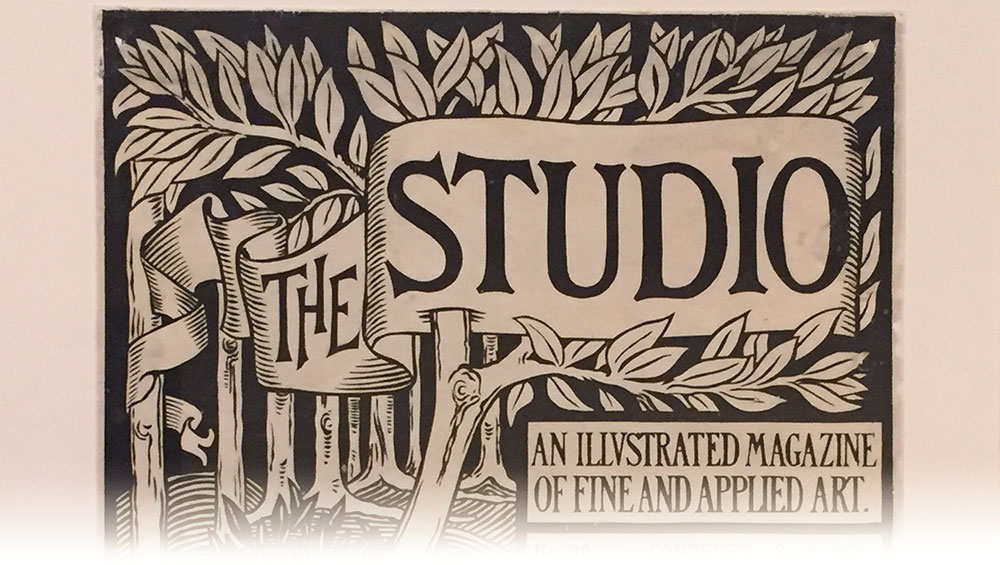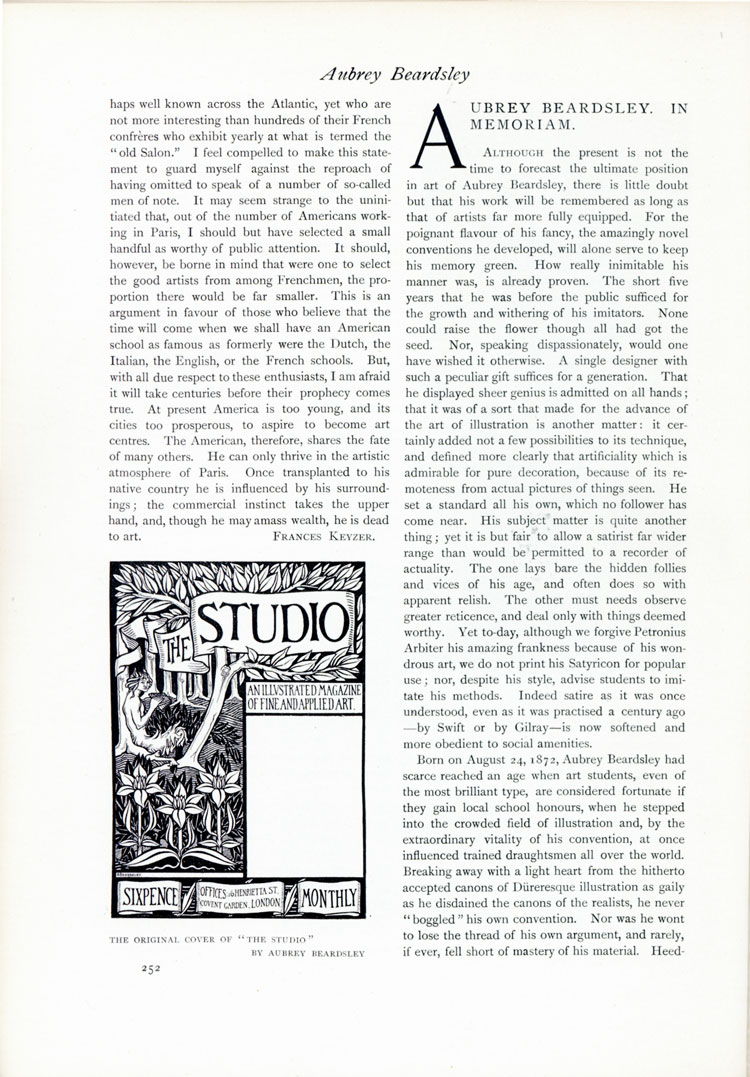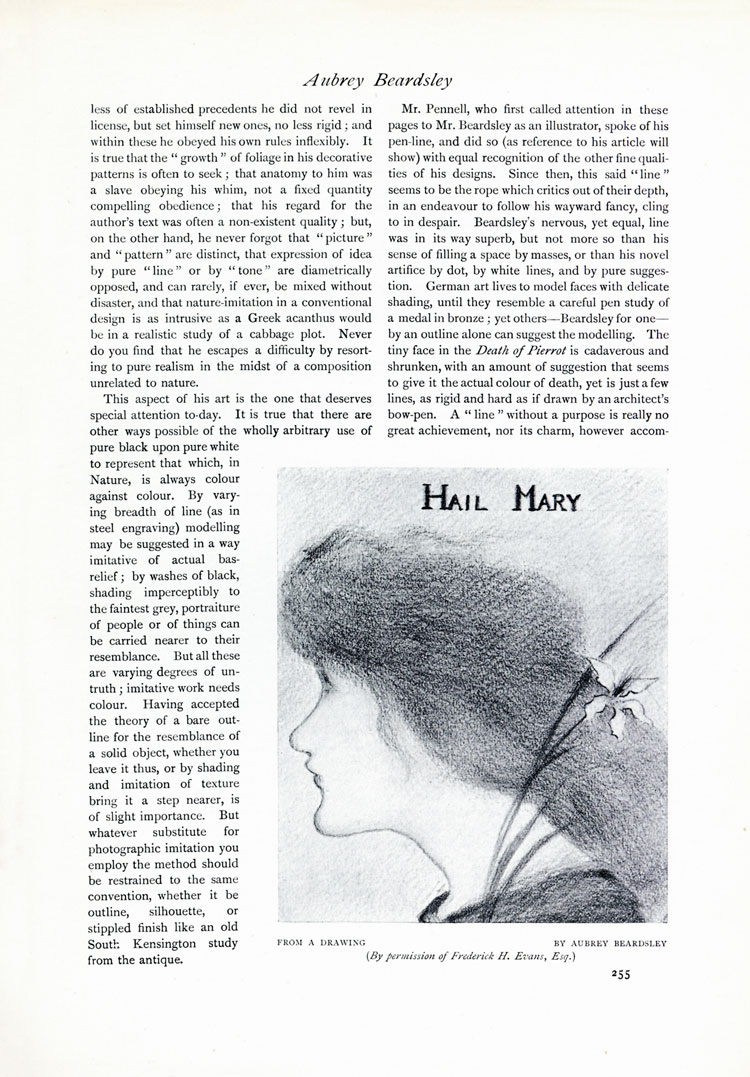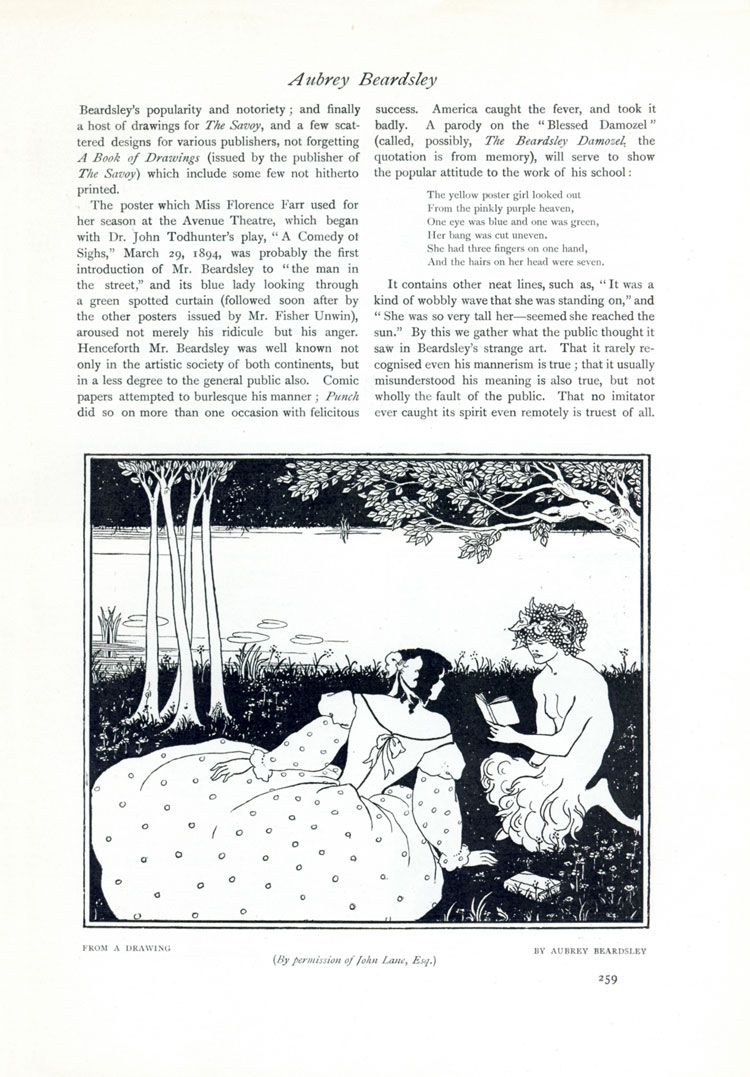
Poster for The Studio magazine, 1898 (detail).
This article was first published in The Studio, Vol 13, 1898, pages 252–263
ALTHOUGH the present is not the time to forecast the ultimate position in art of Aubrey Beardsley, there is little doubt but that his work will be remembered as long as that of artists far more fully equipped. For the poignant flavour of his fancy, the amazingly novel conventions he developed, will alone serve to keep his memory green. How really inimitable his manner was, is already proven. The short five years that he was before the public sufficed for the growth and withering of his imitators. None could raise the flower though all had got the seed. Nor, speaking dispassionately, would one have wished it otherwise. A single designer with such a peculiar gift suffices for a generation. That he displayed sheer genius is admitted on all hands; that it was of a sort that made for the advance of the art of illustration is another matter: it certainly added not a few possibilities to its technique, and defined more clearly that artificiality which is admirable for pure decoration, because of its remoteness from actual pictures of things seen. He set a standard all his own, which no follower has come near. His subject matter is quite another thing; yet it is but fair to allow a satirist far wider range than would be permitted to a recorder of actuality. The one lays bare the hidden follies and vices of his age, and often does so with apparent relish. The other must needs observe greater reticence, and deal only with things deemed worthy. Yet to-day, although we forgive Petronius Arbiter his amazing frankness because of his wondrous art, we do not print his Satyricon for popular use; nor, despite his style, advise students to imitate his methods. Indeed satire as it was once understood, even as it was practised a century ago – by Swift or by Gilray – is now softened and more obedient to social amenities.

Aubrey Beardsley. In Memoriam. The Studio, An Illustrated Magazine of Fine and Applied Art, Vol 13, 1898, page 252. © Studio International Foundation.
Born on August 24, 1872, Aubrey Beardsley had scarce reached an age when art students, even of the most brilliant type, are considered fortunate if they gain local school honours, when he stepped into the crowded field of illustration and, by the extraordinary vitality of his convention, at once influenced trained draughtsmen all over the world. Breaking away with a light heart from the hitherto accepted canons of Düreresque illustration as gaily as he disdained the canons of the realists, he never “boggled” his own convention. Nor was he wont to lose the thread of his own argument, and rarely, if ever, fell short of mastery of his material. Heedless of established precedents he did not revel in license, but set himself new ones, no less rigid ; and within these he obeyed his own rules inflexibly. It is true that the " growth " of foliage in his decorative patterns is often to seek ; that anatomy to him was a slave obeying his whim, not a fixed quantity compelling obedience; that his regard for the author's text was often a non-existent quality; but, on the other hand, he never forgot that “picture” and “pattern” are distinct, that expression of idea by pure “line” or by “tone” are diametrically opposed, and can rarely, if ever, be mixed without disaster, and that nature-imitation in a conventional design is as intrusive as a Greek acanthus would be in a realistic study of a cabbage plot. Never do you find that he escapes a difficulty by resorting to pure realism in the midst of a composition unrelated to nature.

Aubrey Beardsley. In Memoriam. The Studio, An Illustrated Magazine of Fine and Applied Art, Vol 13, 1898, page 255. © Studio International Foundation.
This aspect of his art is the one that deserves special attention to-day. It is true that there are other ways possible of the wholly arbitrary use of pure black upon pure white to represent that which, in Nature, is always colour against colour. By varying breadth of line (as in steel engraving) modelling may be suggested in a way imitative of actual bas-relief; by washes of black, shading imperceptibly to the faintest grey, portraiture of people or of things can be carried nearer to their resemblance. But all these are varying degrees of untruth; imitative work needs colour. Having accepted the theory of a bare outline for the resemblance of a solid object, whether you leave it thus, or by shading and imitation of texture bring it a step nearer, is of slight importance. But whatever substitute for photographic imitation you employ the method should be restrained to the same convention, whether it be outline, silhouette, or stippled finish like an old South Kensington study from the antique.

Aubrey Beardsley. In Memoriam. The Studio, An Illustrated Magazine of Fine and Applied Art, Vol 13, 1898, page 257. © Studio International Foundation.
Mr. Pennell, who first called attention in these pages to Mr. Beardsley as an illustrator, spoke of his pen-line, and did so (as reference to his article will show) with equal recognition of the other fine qualities of his designs. Since then, this said “line” seems to be the rope which critics out of their depth, in an endeavour to follow his wayward fancy, cling to in despair. Beardsley's nervous, yet equal, line was in its way superb, but not more so than his sense of filling a space by masses, or than his novel artifice by dot, by white lines, and by pure suggestion. German art lives to model faces with delicate shading, until they resemble a careful pen study of a medal in bronze ; yet others – Beardsley for one – by an outline alone can suggest the modelling. The tiny face in the Death of Pierrot is cadaverous and shrunken, with an amount of suggestion that seems to give it the actual colour of death, yet is just a few lines, as rigid and hard as if drawn by an architect's bow-pen. A “line” without a purpose is really no great achievement, nor its charm, however accomplished, a new discovery. Hogarth's famous “line of beauty” is of small value, unless it play its proper part in the scheme of beauty. The real beauty of Beardsley's work is often overlooked. It is true that it was rarely or never “pretty”; but that at times it possessed beauty according to academic canons, both in figures and pattern, could be proved up to the hilt. His caricatures and his grotesques have blinded critics to the other side of his art, which is present in The Coiffing and several of his later designs, as it is also in some of the earlier. Turning back to Hamlet patris manem sequitur, a wonderful study (reproduced in The Bee, the magazine of Blackburn Technical School, November 1891), one is re-impressed by its weird beauty; in the curious intensity of Hamlet's slim figure, swathed in drapery, with one nervous hand clutching his throat, while the other is outstretched against a tree, one finds those qualities which first revealed themselves had even then found clear expression. Yet at this time he was but nineteen years old, and had not devoted himself to art as a profession. His former schoolmaster, Mr. E. J. Marshall, of the Brighton Grammar School, says that he studied art privately, and was for a time in an architect's office; but all that is wonderful in the early work is entirely opposed to anything he would have been taught in either place. Even in the school-boy drawings to The Pay of the Pied Piper, which appeared in Past and Present, the Brighton Grammar School magazine, February 1889, there is a hint, slight but still definite, of his personal manner. A fellow school-boy speaks of his delight at that time in Japanese fans and lanterns which crowded the shop windows; and this glimpse of the art of Japan at its poorest, coupled with evident study of Sir E. Burne-Jones' work, are the only extraneous influences apparent in his earlier designs. Nor, despite his keen interest in contemporary work, especially French, do we find any notable influence in his later work.

Aubrey Beardsley. In Memoriam. The Studio, An Illustrated Magazine of Fine and Applied Art, Vol 13, 1898, page 259. © Studio International Foundation.
After the few things which appeared in school magazines, nothing of importance seems to have been published until the time he was, in the pages of THE STUDIO, formally introduced to the public, and took it by storm. It may be as well here to summarise the various incidents of this time – the early months of 1893 – by way of correcting many misconceptions that have arisen.
Still clerk in an insurance office in the city, he had done a certain number of drawings for his own amusement. These (including some afterwards reproduced in THE STUDIO, No. I) had been brought to the notice of various people, including Sir Edward Burne-Jones, Mr. Aymer Valiance, Mr. F. H. Evans and others. Mr. Evans, by whose kindness Hail Mary is here reproduced for the first time, showed that drawing to Mr. J. M. Dent, and said, “Here is the right person to illustrate your ‘Morte d'Arthur.’” Mr. Dent was so far impressed by it that he gave Mr. Beardsley an opportunity of trying his hand on an Arthurian subject, the result being the design reproduced in the photogravure to the second volume of the work – The Achieving of the San Greal, which won him his first big commission. Meanwhile preparations for the publication of THE STUDIO were in progress, and the promoters of the magazine had seen the portfolio, and chosen certain drawings for their first number, for which Mr. Pennell had written his well known appreciation. At this time Mr. Lewis Hind had just accepted the editorship of the Pall Mall Budget, and gave Mr. Beardsley a commission to illustrate current events in his weekly paper. But the drawings representing characters in Tennyson's “Becket” and in Gluck's “Orpheus,” both performed at the Lyceum, which appeared in the Pall Mall Budget, February 9 and March 16, 1893 (with others of less importance in the numbers for February 2, 16, 23, March 9, 23, and 3o), do not appear to have aroused much curiosity regarding the new illustrator.
It is with No. 1 of THE STUDIO, April 1893, which contained Siegfried, The Birthday of Madame Cigale, Les Revenants de Musique, Salome and three subjects from the “Morte d'Arthur,” accompanied by Mr. Pennell's sympathetic article, that Beardsley's formal recognition is to be dated. The first part of the “Morte d'Arthur” was therein announced as ready “in June next.” In THE STUDIO, No. 2, appeared a large reproduction of a pen drawing of the Jeanne d'Arc Procession (another version of the pencil study of the same subject owned by Mr. F. H. Evans). Then came the serial issue of the “Morte d'Arthur,” the “Bon-Mots” grotesques, two notable compositions for The Pall Mall Magazine, and not long after The Yellow Book, No. I, April 1894, which in its first four volumes contained seventeen of his designs. The idea of this periodical with Mr. Aubrey Beardsley for its art editor, grew out of a suggestion for a book of masques he was preparing. Still later followed cover and title designs for twenty-one volumes, the “Keynote Series,” and “Salome,” decorations for the Pierrot Library, and many another work published by Mr. John Lane, which established Beardsley's popularity and notoriety; and finally a host of drawings for The Savoy, and a few scattered designs for various publishers, not forgetting A Book of Drawings (issued by the publisher of The Savoy) which include some few not hitherto printed.
The poster which Miss Florence Farr used for her season at the Avenue Theatre, which began with Dr. John Todhunter's play, “A Comedy of Sighs,” March 29, 1894, was probably the first introduction of Mr. Beardsley to “the man in the street,” and its blue lady looking through a green spotted curtain (followed soon after by the other posters issued by Mr. Fisher Unwin), aroused not merely his ridicule but his anger. Henceforth Mr. Beardsley was well known not only in the artistic society of both continents, but in a less degree to the general public also. Comic papers attempted to burlesque his manner; Punch did so on more than one occasion with felicitous success. America caught the fever, and took it badly. A parody on the “Blessed Damozel” (called, possibly, The Beardsley Damozel the quotation is from memory), will serve to show the popular attitude to the work of his school:
The yellow poster girl looked out
From the pinkly purple heaven,
One eye was blue and one was green,
Her bang was cut uneven.
She had three fingers on one hand,
And the hairs on her head were seven.
It contains other neat lines, such as, “It was a kind of wobbly wave that she was standing on,” and “She was so very tall her – seemed she reached the sun.” By this we gather what the public thought it saw in Beardsley's strange art. That it rarely recognised even his mannerism is true; that it usually misunderstood his meaning is also true, but not wholly the fault of the public. That no imitator ever caught its spirit even remotely is truest of all.
Beardsley himself spoke of a famous artist as “the imitable Mr. So and So”; no one could retort in kind, for the fact (whether it is one to be regretted or approved is not the question) remains that Beardsley stood, and needs must stand, alone. He is as remote from the pre-Raphaelites, the neo-Primitives, and the so-called Decorative School as he is from the impressionists and the actualists. Whether you regard his as a portent or “a sport” (as science uses the word), he represented a new departure, but kept the secret of his “style” all his own.
He was a satirist or a decorator, at times both; but never, one fancies, a conscious preacher. Above all, he was an artist literally to his fingertips. Indeed, to sit behind him at a performance of “Tristan and Isolde,” and watch those transparent hands clutching the rail in front, and thrilling with the emotion of the music, was in itself a marvellous experience. No instrument in the orchestra vibrated more instantly in accord with the changes of the music, from love-passion to despair. Dowered prodigally by nature, so that he would doubtless have made his mark no less in music or in literature had he preferred sounds or words to line, he was content to devote himself to a small corner of art, and in “black-and-white,” he alternately astonished, shocked, and delighted an increasing audience during the four years of his active work. “Sleep is a cave into which I crawl and forget the world,” Robert Louis Stevenson once said in friendly converse; Beardsley never seems to have slept, he worked far into the night, and by day seemed always active. He never forgot the strange unreal world he studied. His fantasy often crossed the border-line, his extravagances were more than many could tolerate, he was impish in his disregard for decorum, but with his art he played no tricks. Whether working with broad masses, white silhouette on black, or even black on black, he escaped confusion in pure line. He never attempted modelling, nor was concerned by cast shadow; and in the later methods used in The Rape of the Lock and Vol-pone, and many of his Savoy designs, he set himself to develop a style which, while it suggests wood-engravings of the sixties so long as you do not place examples of each side by side, is no less his own than were his first drawings executed in pure line or in pure mass.
To-day it has been said that his figures are but puppets in vacuum. He evidently intended them to be simulacri only, and recognised that atmosphere which belongs to colour, and can be only faintly suggested by a scheme of varying blacks and greys, is not essential to the art of black and white. His ingenious decoration, which invented new “motives” by the score, that designers of conventional patterns have not been slow to imitate, is too obvious to need comment. His curious fondness for candelabra betrays itself in a very early drawing (unluckily not adapted for reproduction) (owned by Mr. H. A. Payne, of Brighton, who most kindly put it at our disposal); so certain pieces of ornate rococo furniture attracted him again and again, and so a draped toilet-table, not hitherto a joy to artists, is frequent in his work. To these properties he returned as often as did Du Maurier to his big chintz-covered couch, and his dumpy vases on a chimney-piece. Lighted candles had a curious fascination for him; he drew chiefly by artificial light, and wherever he could introduce these he did. Perhaps the designs which are most entirely his own are those based on subjects from Wagner's operas. Certainly they owe nothing to the stage effects the composer himself arranged. That, in face of pictures so well established as those of Siegfried, Fafner, or the Third and Fourth Tableaux of the Rheingold, he should have evolved wild fantasies wholly dissimilar, betrays the curious colouring which all themes, whether of opera, legend or common life, took on as they passed through his mind. The Third Ballade of Chopin, reproduced here for the first time, is an instance of this. It is doubtful whether any listener had formed such an image of its meaning before. Some who saw it (when the original was exhibited) say they will never hear the music again without picturing this interpretation in their minds. Speaking personally, neither the Wagner nor the Chopin themes seem directly inspired by the music, any more than are most of the “Morte d’Arthur” drawings by Mallory's text. The beautiful study of Madame Réjane is given in facsimile of the original, owned by Mr. F. H. Evans, who also possesses a remarkable decorative panel of Perseus.
Death has given Aubrey Beardsley the immortality of youth; and in future histories of illustration, whether for blame or praise, men must needs add that it was a mere boy who did these things, and did them as no other had ever attempted to do them before. G.W.